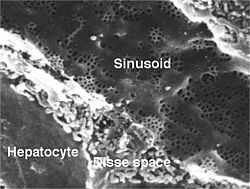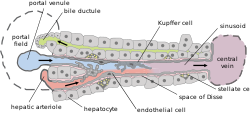Space of Disse
| Perisinusoidal space | |
|---|---|

Sinusoid of a rat liver with fenestrated endothelial cells. Fenestrae are approx 100 nm diameter, and the sinusoidal width 5 µm. Scanning electron micrograph by Robin Fraser, University of Otago.
|
|

Basic liver structure
|
|
| Details | |
| Identifiers | |
| Latin | spatium perisinusoideum |
| Code | TH H3.04.05.0.00012 |
| TH | H3.04.05.0.00012 |
|
Anatomical terminology
[]
|
|
The perisinusoidal space (or space of Disse) is a location in the liver between a and a sinusoid. It contains the blood plasma. Microvilli of hepatocytes extend into this space, allowing proteins and other plasma components from the sinusoids to be absorbed by the hepatocytes. Fenestration and discontinuity of the endothelium, as well as its basement membrane, facilitates this transport. This space may be obliterated in liver disease, leading to decreased uptake by hepatocytes of nutrients and wastes such as bilirubin.
The perisinusoidal space also contains hepatic stellate cells (also known as cells of Ito), which store fat or fat soluble vitamins including vitamin A). A variety of insults that cause inflammation can result in the cells transforming into myofibroblasts, resulting in collagen production, fibrosis, and cirrhosis.
The Space of Disse was named after German anatomist Joseph Disse (1852–1912).
...
Wikipedia
